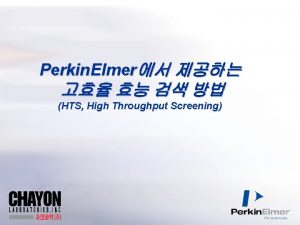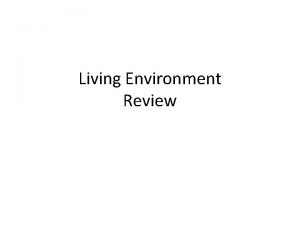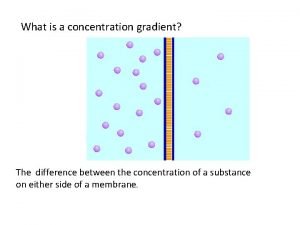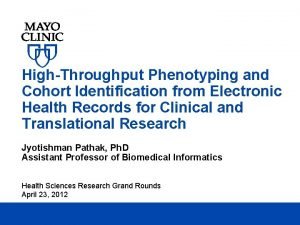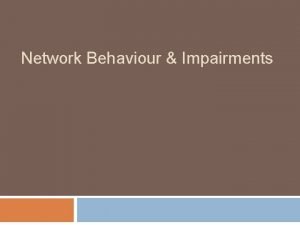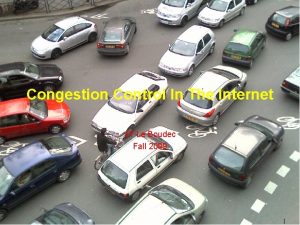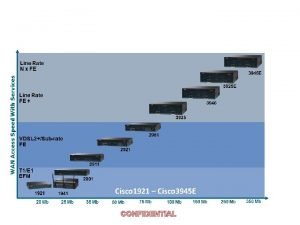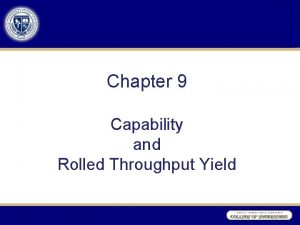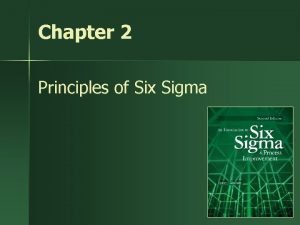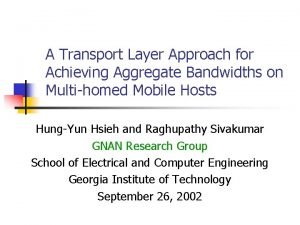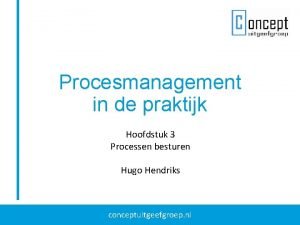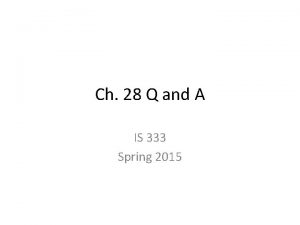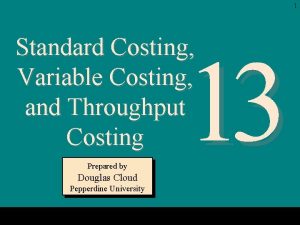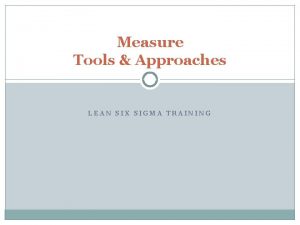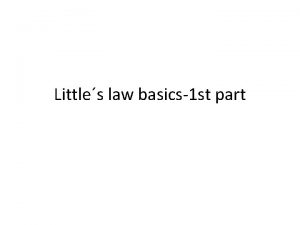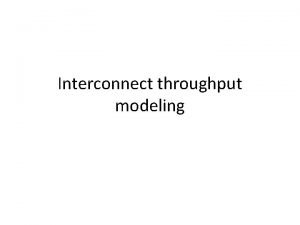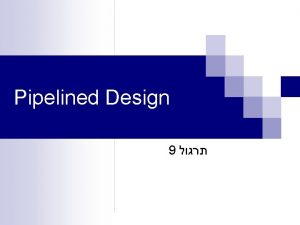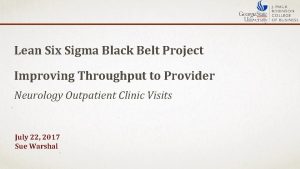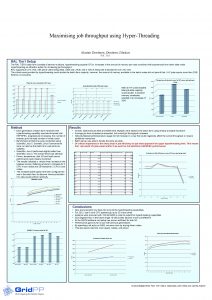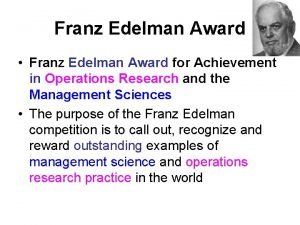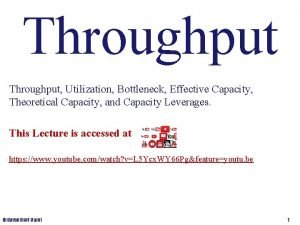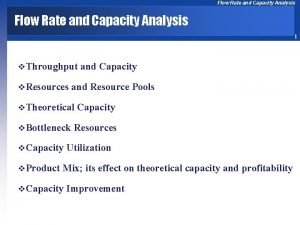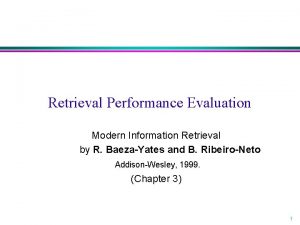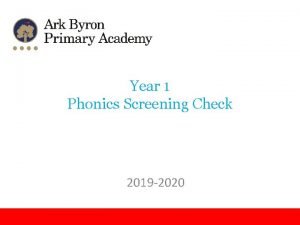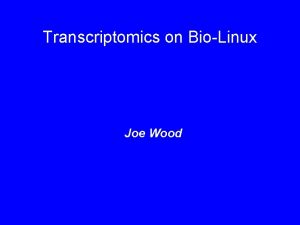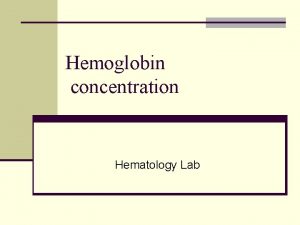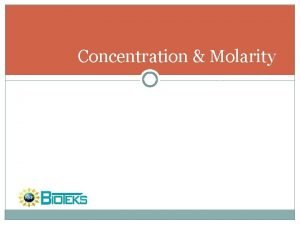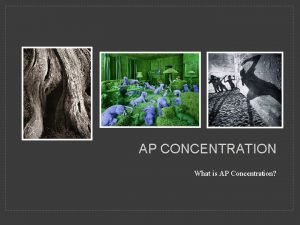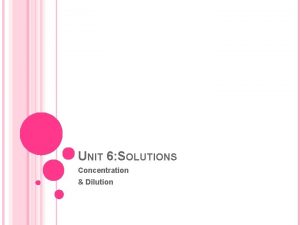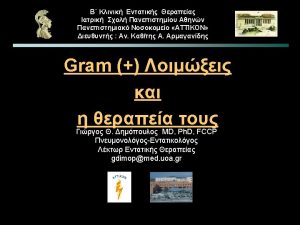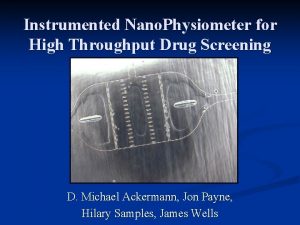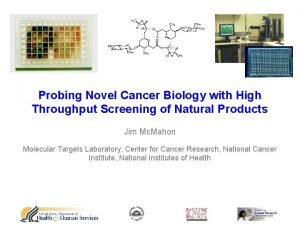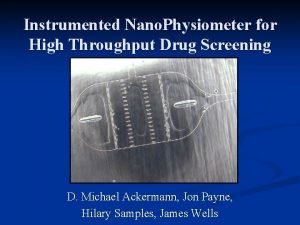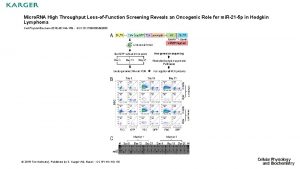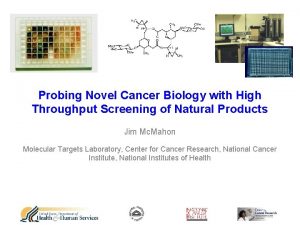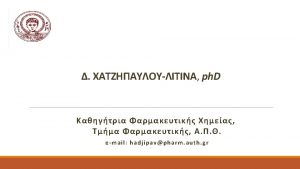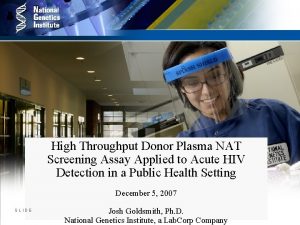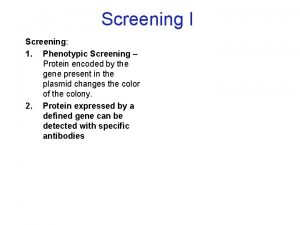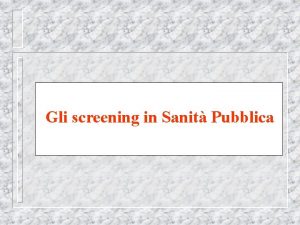High Throughput Transcriptomics HTTr Concentration Response Screening in






















![Total Mapped Reads vs. Percent Mapped Reads [All Plates] • Average total mapped reads Total Mapped Reads vs. Percent Mapped Reads [All Plates] • Average total mapped reads](https://slidetodoc.com/presentation_image_h/749c47115c5a35893cb9e6c219512b0b/image-23.jpg)
![Total Mapped Reads vs. Percent Mapped Reads [By Plates] • Comet tail Due to Total Mapped Reads vs. Percent Mapped Reads [By Plates] • Comet tail Due to](https://slidetodoc.com/presentation_image_h/749c47115c5a35893cb9e6c219512b0b/image-24.jpg)















![Network Mapping [Clomiphene Citrate] p-value • Reactome (v 60) Pathway Hierarchy Overlaid with enrichment Network Mapping [Clomiphene Citrate] p-value • Reactome (v 60) Pathway Hierarchy Overlaid with enrichment](https://slidetodoc.com/presentation_image_h/749c47115c5a35893cb9e6c219512b0b/image-40.jpg)





- Slides: 45

High Throughput Transcriptomics (HTTr) Concentration. Response Screening in MCF 7 Cells Joshua A. Harrill, Ph. D. Photo image area measures 2” H x 6. 93” W and can be masked by a collage strip of one, two or three images. The photo image area is located 3. 19” from left and 3. 81” from top of page. Each image used in collage should be reduced or cropped to a maximum of 2” high, stroked with a 1. 5 pt white frame and positioned edge-to-edge with accompanying images. Office of Research and Development Full Name of Lab, Center, Office, Division or Staff goes here. <Go to View, Master, Title Master to change> October 26, 2017

Conflict of Interest Statement • No conflict of interest declared. • Disclaimers: • The views expressed in this presentation are those of the author and do not necessarily reflect the view or policies of the USEPA. • This presentation does not necessarily reflect USEPA policy. Mention of trade names or commercial products does not constitute an endorsement or recommendation for use by USEPA. • Data in this presentation is the result of preliminary analyses. Office of Research and Development Full Name of Lab, Center, Office, Division or Staff goes here. <Go to View, Master, Slide Master to change> 2

Outline • Background & Objectives • HTTr Pilot Experiment • Optimization Steps • Attenuation • Experimental Layout • Results • Assay Performance Metrics • Concentration-Response Modeling • Current Activities & Future Directions

Background • Tox. Cast assays cover about 320 genes. • Pathway coverage is higher but still leaves large gaps • Recent technological advances in transcriptomics are very promising for rapid and cost-effective whole transcriptome screening. • Increase biological coverage by using high throughput transcriptomics (HTTr) as broad-based Tier 0 bioactivity screen.

Bio. Spyder Temp. O-Seq • Targeted RNA-Seq technology • Whole transcriptome assay provides output on > 20, 000 transcripts. • Requires very low input (< 10 pg total RNA). • Performed on “standard” PCR and Next Gen Sequencers. • Compatible with purified RNA or cell lysates. www. biospyder. com www. illumina. com

Objectives • Optimize culture and assay conditions for HTTr screening in MCF 7 cells using the Temp. O-Seq human whole transcriptome assay. • Perform a pilot experiment with a limited number of chemicals (n=44) in order to: 1) Evaluate Temp. O-Seq assay performance. 2) Determine the ability of the Temp. O-Seq assay to detect known biological signatures following chemical perbations 3) Guide experimental design of larger screening studies.

HTTr Pilot: Experimental Design Parameter Multiplier Notes Cell Type(s) 1 MCF 7 Culture Condition 2 DMEM + 10% HI-FBS PRF-DMEM + 10% CS-HI-FBS Chemicals 44 see subsequent slides Time Points: 3 6, 12, 24 hours Assay Formats: 3 Temp. O-Seq HCI-Apoptosis HCI-Cytotoxicity Concentrations: 8 3. 5 log 10 units; ½ log 10 spacing Biological Replicates: 4 3 Temp. O-Seq; 1 Reserve MCF 7 cells cultured in DMEM + 10% HI-FBS was selected as the test system to facilitate comparability to the Broad Institute Connectivity Map (CMAP) database (http: //portals. broadinstitute. org/cmap/). a B a Dulbecoo’s Modified Eagle’s Media (Media. Tech 10 -013) + Heat-Inactivated FBS (Sigma-Aldrich F 4135) Phenol Red Free Dulbecco’s Modified Eagle’s Media (Media. Tech 17 -205) + Charcoal-Stripped Heat-Inactivated FBS (Sigma-Aldrich 6765)

HTTr Pilot: Workflow Track 1: Targeted RNA-Seq Generating Cell Lysates Generate Cryopreserved Cell Stocks Temp. O-Seq WT Cell Dosing Cell Expansion Cell Plating Track 2: Cytotoxicity / Apoptosis Cell Labeling Bio. Tek Multi. Flo FX High Content Imaging Lab. Cyte Echo® 550 Liquid Handler Thermo Cellomics Array. Scan® VTI HCS Reader

Assay Optimization • MCF 7 Cell Culture • • Authentication Expansion Protocol Media Formulation Seeding Density • Temp. O-Seq Assay • Lysis Conditions • Attenuation of Highly Expressed Genes • Chemical Treatments • Concentration Range • Plate Map Design • Exposure Duration

MCF 7 Expansion Protocol Day In Vitro (DIV): 0 2 4 P 3 (from Cryo) Action: Seed MC Vessel: T 25 6 8 P 4 P MC T 75 10 MC = Media Change P = Passage 12 P 5 P MC T 225 P 6 P Test Plate(s) Perform Experiment Stage Culture Vessel Average Cell Yield a Number of Treatment Wells b Number of Test Plates c Initial Seeding NA 1. 28 x 107 182 0. 47 P (3 4) T 25 2. 43 x 107 346 0. 90 P (4 5) T 75 5. 86 x 107 837 2. 18 P(5 6) T 225 1. 47 x 108 2100 5. 47 a Median values from c 2017 -08 -14, c 2017 -08 -15, c 2017 -08 -19, c 2017 -08 -20 Assumes 384 well plate, 10, 000 cells / well. c For experimental needs > 5 plates / experiment, expand multiple cryopreserved MCF 7 cell aliquots in parallel. Pool at each passaging stage. b • MCF 7 Cells authenticated by STR Profiling and karyotyping prior to use in screening studies.

Media Effects on MCF 7 Growth • DMEM + 10% HI-FBS contains phenol red an unknown compliment of serum factors which may stimulate ER activation. • Phenol red-free media with charcoal-stripped FBS reduces endogenous estrogen receptor activation. DMEM + 10% HI-FBS PRF-DMEM + 10% CS-HI-FBS Qualitative Observations 24 HR • More cell attachment and cell spreading with PRF-DMEM + 10% CS-HI-FBS. • Greater increase in cell confluency over time in PRF-DMEM + 10% CS-HI-FBS. • More proliferation over time in DMEM + 10% HI-FBS. 48 HR

Attenuation • A method used with Bio. Spyder Temp. O-Seq assay to prevent highly expressed genes from occupying a disproportionate amount of available read space and increase the ability to quantify low abundance transcripts. • Attenuation is accomplished by adding “cold probes” which compete with matching DOs for hybridization sites on target RNAs. • The attenuation probe will bind to the same site as the detector oligos, thus decreasing the amount of the target RNA species available for PCR amplification. • For attenuation, the end user must define: • The set of genes to be attenuated, and… • What degree of attenuation is appropriate • Question(s): • Is additional attenuation needed in the MCF 7 cell model? • If so, how is the attenuation set defined?

A Distribution of Read Counts C. Resp. 2 B C. Resp. 1 Time Course Table 1. Number of DOs Accounting for 50% of Total Read Space, Per Sample Basis Media Type Treatment Type DMEM DMEM PRF. DMEM ------DMSO TSA, 1 µM Treatment Time, h Sample Time, h -30 -36 -48 24 30 30 36 Range of DO Counts: Replicate Number 1 2 3 242 273 238 276 268 240 308 231 307 273 242 192 245 220 246 220 249 288 240 259 248 303 278 233 222 242 273 186 - 322 186 208 239 289 244 262 269 253 322 303 249 208 232 263 Results • Read count distributions similar across samples. • Broad range of read counts within each sample (0 - ~32 K). • Within each sample, ~50 -60% of DOs with non-zero read counts. • Between 186 - 322 DOs account for 50% of the available read space (varies with sample).

Evaluating Commonality of Highly Expressed Genes Across Test Conditions Gate = 50 % Total # of DOs * Using a Gate of 50 % of the total read space (*): • Commonality Score = 14: ~ 30% of the DOs are identified as “highly-expressed” in all 14 test conditions (red). • Commonality Score = 1: ~12. 5% are identified as “highly-expressed” in only 1 test condition (blue). • Commonality Score = 2 – 13: Varying number of DOs (< 10%) identified as “highly-expressed” in 2 to 13 test conditions. • Variance: Tended to increase in DOs with lower commonality scores. Conclusions: • At Gate = 50 %, DOs with Commonality Scores of 14 are consistently identified as “highly-expressed” across all test conditions and have relatively lower variance and higher read counts across all test conditions. • N = 156 DOs identified as candidates for attenuation.

Candidate “Highly Expressed Genes” for Attenuation N = 156 • Rank ordered on x-axis by average read count across all test conditions. • Green line Raw read count = 100. • The most highly expressed genes in the attenuation set are “housekeeping” genes.

HTTr Pilot: Chemical Test Set Chemical Name Flutamide Nilutamide Cyproterone acetate Vinclozolin 4 -Hydroxytamoxifen Clomiphene citrate (1: 1) Fulvestrant Atrazine Cyanazine Simazine Cladribine Cycloheximide Bisphenol A Bisphenol B 4 -Nonylphenol, branched 4 -Cumylphenol Clofibrate Fenofibrate Lovastatin Simvastatin Bifenthrin Cypermethrin MIE Family ANTIANDROGEN ANTIESTROGEN c. AMP INDUCERS / PDE INHIBITORS CYTOTOXICANTS ESTROGENS FIBRATES HMGCR NA+ CHANNEL Chemical Name Rotenone Fenpyroximate (Z, E) Trifloxystrobin Pyraclostrobin PFOS PFOA Troglitazone Farglitazar Lactofen Fomesafen Butafenacil Maneb Thiram Ziram Imazalil Prochloraz Cyproconazole Propiconazole Tetrac 3, 5, 3'-Triiodothyronine Reserpine Amiodarone hydrochloride MIE Family MITOCHONDRIA (COMPLEX I) MITOCHONDRIA (COMPLEX II) PPAR PPO INHIBITOR / PPAR PPO INHIBITOR SH REACTIVE STEROIDOGENESIS THR VMAT • Chemical set covers broad range of mechanistic diversity with redundancy within mechanistic class.

Dose Range Selection 100 µM • Upper bound in testing range set at 100 µM based on upper limit of cytotoxicity range for most chemicals. • Final dose range: 0. 03, 0. 1, 0. 3, 1, 3, 10, 30, 100 µM

Dosing Plate Layout Test Chemicals • • 44 chemicals in 8 -point concentration-response all on one plate Non-treated (n=3) and DMSO (n=3) control wells. Three “CMAP” Reference Compounds, single point, in triplicate First column reserved for addition of RNA QC samples by NCCT (pre-shipment) and Bio. Spyder (post-shipment). Untreated DMSO (vehicle control) CMAP Reference HCI No Label Controls HCI Pos. & Neg. Controls

Dose Randomization using Echo 550 Acoustic dispensing technology: • Uses soundwaves to precisely transfer small quantities of liquid (n. L) from source plate to test plate. • Allows for randomization of test wells mitigate potential edge effects without “losing real estate. ” Source Plate Test Plate Lab. Cyte Echo® 550 Liquid Handler

Echo Dispensing Evaluate technical reproducibility. Shipping control Evaluate technical reproducibility for cell lysates No Template Control UHRR (Us) HBRR (Us) Bulk Lysate (DMSO) Bulk Lysate (TSA) Lysis Buffer (Us) UHRR (Them) HBRR (Them) Lysis Buffer (Them) • RNA QC samples allow tracking of protocol reproducibility and assay performance across experimental replicates. • The randomization scheme is unique for each plate UHRR = Universal Human Reference RNA HBRR = Human Brain Reference RNA HTTr Cytotoxicity OR Apoptosis HCI Labeling

DRAFT Data Analysis Pipeline Sample Level Fastq sequence alignment; Sum read counts Probe Level Gene Level Resequence ? Exclude sample Filter for cytotoxicity or minimum mapped read depth Y N Subset data by chemical x media x time (+ matching DMSO) DESeq 2 • Normalize to constant 3 M Read Depth • Apply shrinkage estimations Benchmark Dose Modeling Gene Level Summary Pathway Enrichment FC Estimates (with SD/SE & p-value) Gene Level Summary MIE/MOA Identification Filter probes using a median raw read count > 5 21 Exclude Probe N Y PRELIMINARY: Workflow for the Data Analysis Pipeline in an active area of research and may change in the future. 21

Assay Performance Metrics • Total Mapped Reads vs. Percent Mapped Reads • Correlation and Variation in Technical Replicates [within plate] • Correlation and Variation in Biological Replicates [across plates] • Detection of Biological Signal • Transcriptional Biomarkers • Connectivity Mapping
![Total Mapped Reads vs Percent Mapped Reads All Plates Average total mapped reads Total Mapped Reads vs. Percent Mapped Reads [All Plates] • Average total mapped reads](https://slidetodoc.com/presentation_image_h/749c47115c5a35893cb9e6c219512b0b/image-23.jpg)
Total Mapped Reads vs. Percent Mapped Reads [All Plates] • Average total mapped reads of test samples ~ 3. 0 x 106 • Average mapped read count per gene ~150 • Percent mapped reads > 75% • Lysis Buffer blanks have low total reads, but not zero. • Purified RNAs clustered at upper left. • Comet tail ? • Off-set cluster ?
![Total Mapped Reads vs Percent Mapped Reads By Plates Comet tail Due to Total Mapped Reads vs. Percent Mapped Reads [By Plates] • Comet tail Due to](https://slidetodoc.com/presentation_image_h/749c47115c5a35893cb9e6c219512b0b/image-24.jpg)
Total Mapped Reads vs. Percent Mapped Reads [By Plates] • Comet tail Due to one “poor performing” plate • Offset cluster Low read count samples across many plates (red circles) Candidates for resequencing.

Correlation Among Technical Replicates • Correlation among technical replicates is high (> 0. 85 %).

Coefficient of Variation (CV) Among Technical Replicates • Coefficient of variation in gene expression values is low (median ~30 %).

Correlations in Biological Replicates, Stratified by Expression Level Counts Log 2 FC DEGs • Correlations of raw counts and log 2 FC of DEGs is high (> 0. 85) for most conditions.

Coefficient of Variation (CV) Stratified by Expression Level • CVs decrease as a function of mean expression level.

ERa Biomarker Signature DRAFT WORK PRODUCT – DO NOT DISTRIBUTE • Biomarker signature determined by treating MCF 7 cells with various ERa agonists and antagonists. • Can we use this to detect biologically meaningful signal in the Bio. Spyder data? Ryan et al. (2016) EGR 3 MYBL 1 SGK 1 RET JAK 2 CXCL 12 NMRK 1 AREG SGK 3 PLAUR PTGES SMOX CD 44 FHL 2 RAPGEFL 1 ABHD 2 SVIL CCND 1 FOXC 1 PDZK 1 TFAP 2 C WWC 1 PGR PRSS 23 OLFM 1 MICAL 2 SLC 7 A 5 CA 12 RCL 1 MYB SIAH 2 RBBP 8 ALAD RHBDF 1 PIK 3 R 3 KYNU DYRK 2 ID 3 CLMN PLEKHF 2 SSBP 2 EFNA 1 TFAP 2 A TFPI EPHA 4 CCNG 2 3. 16 1. 9 1. 81 1. 7 1. 62 1. 6 1. 58 1. 47 1. 46 1. 45 1. 44 1. 42 1. 38 1. 37 1. 36 1. 35 1. 33 1. 29 1. 27 1. 25 1. 24 -1. 26 -1. 27 -1. 29 -1. 31 -1. 35 -1. 42 -1. 45 -1. 46 -1. 48 -1. 49 -1. 52 -1. 77 •

Correlation with ERa Transcriptional Biomarker 1 1 2 Chemical MOA Fulvestrant Antiestrogen (SERD) 4 Hydroxytamoxifen 3 Clomiphene Citrate 4 Bisphenol A 5 Bisphenol B 6 4 -Nonylphenol, branched 7 4 -Cumylphenol Antiestrogen (SERM) 2 DMEM. 06 3 4 5 6 7 1 2 DMEM. 12 3 4 5 6 7 1 2 DMEM. 24 3 4 5 6 7 0. 03 0. 1 0. 3 10 30 Estrogenic 100 PRF. DMEM. 06 1 0. 03 + Corr 0. 1 0. 3 1 3 - Corr 10 30 100 2 3 4 5 6 PRF. DMEM. 12 7 1 2 3 4 5 6 PRF. DMEM. 24 7 1 2 3 4 5

Correlation with ERa Transcriptional Biomarker - Antagonists • The ability to detect ERa antagonists (particularly SERMs) was decreased by use of charcoal stripped serum.

Connectivity Mapping • Differential gene expression observed with reference chemicals. • Putative targets identified using Connectivity Mapping • Large degree of promiscuity of predicted targets observed. • Currently evaluating additional methods for MIE prediction

Benchmark Dose Modeling Parameter Criteria a Pre-filter: ANOVA (praw < 0. 05 & |FC| > 2) Models Hill, Exponential 2, poly 2, power, linear BMR Factor: 1. 349 (10 %) Best Model Selection: Lowest AIC Hill Model Flagging b: ‘k’ < 1/3 Lowest Positive Dose Retain Flagged Models Pathway Analysis: Genes with BMD <= Highest Dose > 3 > 5% Gene Set Coverage Fisher’s Exact Two Tailed < 0. 05 Gene Set Collections c: MSig. DB_C 2 MSig. DB_H Reactome a b Flagged Exploratory analysis – modeling criteria not finalized Hill Models were retained to illustrate a specific point regarding concentration range selection Gene Set Collections: • MSig. DB_C 2: Curated gene sets from online pathway databases, publications and knowledge of domain experts (n = 4738). • MSig. DB_H: Coherently expressed signatures derived by aggregating many MSig. DB gene sets to represent well-defined biological states or processes (n = 50). • Reactome: Open-source, curated and peer reviewed pathway database with hierarchical pathway relationships in specific domains of biology. (n = 1764). Some pathways included in MSig. DB_C 2. c

Benchmark Dose Modeling Results * * Fulvestrant Clomiphene Citrate MYBL 1_22509 BMD = 7. 769 E-14 µM MYBL 1_22509 BMD = 0. 016 µM • A high occurrence of flagged Hill fits with unreasonably low BMDs may indicate the concentration range was not low enough. • Flagged BMDs were observed with low frequency in this dataset. • The identify of genes with flagged hill models was inconsistent across chemicals. Not driven by DMSO controls.

Benchmark Dose Modeling Results * * • Wide range of chemical potencies at the probe level. • The distribution of probe level BMDs vary from chemical to chemical. • No apparent relationship between potency and number of probes affected (? ). Bisphenol A Bisphenol B

Pathway Enrichment Numbers of Pathways Enriched Chemical Name Ziram 4 -Hydroxytamoxifen Cycloheximide 4 -Nonylphenol, branched Amiodarone hydrochloride Reserpine Maneb Rotenone Thiram 4 -Cumylphenol Bisphenol B Fenpyroximate (Z, E) Cyproterone acetate Prochloraz Clomiphene Citrate Nilutamide Trifloxystrobin Cladribine Bisphenol A Imazalil Pyraclostrobin Farglitazar MSig. DB_C 2 1268 1068 570 533 524 523 248 215 204 198 185 183 166 113 68 56 47 47 45 41 37 22 MSig. DB_H 26 14 24 7 12 11 3 5 5 4 2 5 5 2 3 0 1 0 0 1 Reactome 314 331 126 127 136 80 75 22 64 27 31 14 4 10 0 29 2 71 5 4 1 0 Chemical Name Propiconazole 3, 5, 3'-Triiodothyronine Fenofibrate Cyanazine Flutamide Fulvestrant Cypermethrin Lovastatin Simvastatin Butafenacil Vinclozolin Tetrac Lactofen Cyproconazole Clofibrate PFOS Simazine Fomesafen Troglitazone PFOA Atrazine Bifenthrin • Heterogeneity in the amount and type of pathways enriched. • Changing filtering stringency and BMD modeling strategy affects these results. MSig. DB_C 2 20 18 17 16 10 9 7 6 5 3 2 2 2 0 0 0 0 0 MSig. DB_H Reactome 1 0 0 0 0 0 2 1 1 0 1 0 0 0 0

Pathway Potencies MSig. DB_C 2 Ziram Cycloheximide Thiram • Broad range of pathway level potency estimates and number of pathways affected across chemicals.

Pathway Potencies ER Agonist ER Antagonist MSig. DB_C 2 4 -Nonylphenol, branched 4 -Hydroxytamoxifen 4 -Cumylphenol Bisphenol B Bisphenol A Clomiphene Citrate (1: 1) Fulvestrant • Heterogeneity in pathway levels potency estimates and number of pathways affected within chemical class.

Network Mapping • Reactome (v 60) Pathway Hierarchy
![Network Mapping Clomiphene Citrate pvalue Reactome v 60 Pathway Hierarchy Overlaid with enrichment Network Mapping [Clomiphene Citrate] p-value • Reactome (v 60) Pathway Hierarchy Overlaid with enrichment](https://slidetodoc.com/presentation_image_h/749c47115c5a35893cb9e6c219512b0b/image-40.jpg)
Network Mapping [Clomiphene Citrate] p-value • Reactome (v 60) Pathway Hierarchy Overlaid with enrichment scores based on probes with acceptable BMD model fit • Highlights different areas of biology affected by a chemical

Diversity in Response of Cell Cycle Networks 4 -Nonylphenol Amiodarine Hydrochloride Clomiphene Citrate M-phase G 0 and early G 1 p-value Chromosome maintenance Cycloheximide Rotenone G 2/M Checkpoints Ziram

Diversity in Response of Signal Transduction Networks 4 -Nonylphenol Amiodarine Hydrochloride Clomiphene Citrate RAF/MAPK Cascade p-value Cycloheximide Rotenone Ziram Signaling by Rho. GTPases Signaling by ERBB 2 MAPK 1/MAPK 3 Signaling

Current Activities & Future Directions • Fall 2017: • Refining data analysis pipeline and BMD modeling approach. • Exploring methods for MIE prediction & characterization of biological responses. • Prepping initial publication. • Conducting concentration-response screening of 2, 200 chemicals in MCF 7 cell model (8 conc. , 6 HR exposure). • Beyond 2017: • Tox 21 reference chemical partner project • Screening in additional cell lines. • Coupling with image-based phenotypic screening assay.

Acknowledgements • NCCT • Clinton Willis • Danielle Suarez • Chad Deisenroth • • • Imran Shah Woody Setzer Derek Haggard Matt Martin Richard Judson Rusty Thomas • Bio. Spyder • Joel Mc. Comb • Jo Yeakley • Jason Downing • Milos Babic • Kyle Le. Blanc • Harper Van Steenhouse

Questions ?
 Perkin elmer high content screening
Perkin elmer high content screening High throughput screening
High throughput screening Movement of high concentration to low concentration
Movement of high concentration to low concentration Concentration gradient vs concentration difference
Concentration gradient vs concentration difference High throughput phenotyping
High throughput phenotyping High throughput satellite
High throughput satellite Movement of particles from high to low concentration
Movement of particles from high to low concentration Natural response and forced response
Natural response and forced response Natural response and forced response example
Natural response and forced response example A subsequent
A subsequent Throughput vs latency
Throughput vs latency Throughput formula
Throughput formula Cisco 1921 throughput
Cisco 1921 throughput How to calculate rolled throughput yield
How to calculate rolled throughput yield Six sigma formula
Six sigma formula Throughput vs bandwidth
Throughput vs bandwidth Throughput vs bandwidth
Throughput vs bandwidth Input throughput output voorbeeld
Input throughput output voorbeeld Throughput vs goodput
Throughput vs goodput Throughput costing
Throughput costing Rolled throughput yield vs first pass yield
Rolled throughput yield vs first pass yield Throughput time formula
Throughput time formula Aggregate throughput
Aggregate throughput Learner throughput rates
Learner throughput rates Average throughput
Average throughput Throughput model pmo
Throughput model pmo Throughput vs latency
Throughput vs latency Patient throughput definition
Patient throughput definition Cisco sbtg
Cisco sbtg Average throughput
Average throughput Throughput formula
Throughput formula The throughput billing of cosmosdb is based on
The throughput billing of cosmosdb is based on Can far memory improve job throughput
Can far memory improve job throughput Throughput yield
Throughput yield Berkeley
Berkeley Edelman prize
Edelman prize Throughput flow rate
Throughput flow rate Process capacity analysis
Process capacity analysis High precision vs high recall
High precision vs high recall High precision vs high recall
High precision vs high recall Directive and supportive leadership
Directive and supportive leadership High expectations high support
High expectations high support Low accuracy low precision
Low accuracy low precision Directive behavior and supportive behavior
Directive behavior and supportive behavior High risk high return artinya
High risk high return artinya Phonics screening check 2019
Phonics screening check 2019
